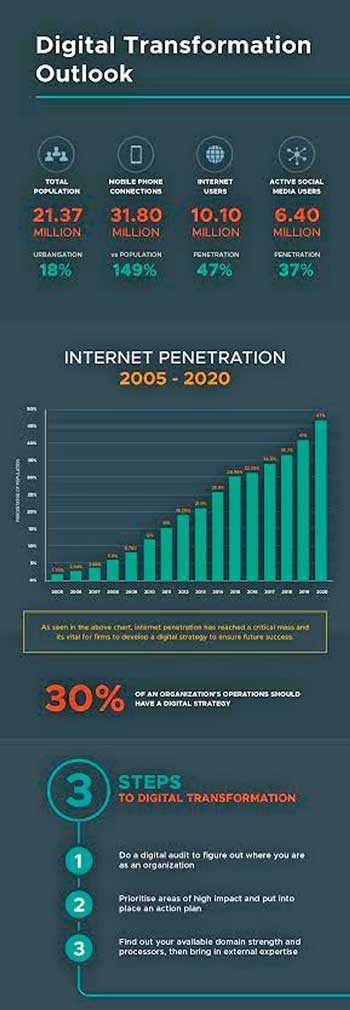Tuesday Dec 09, 2025
Tuesday Dec 09, 2025
Tuesday, 27 October 2020 01:07 - - {{hitsCtrl.values.hits}}
|
Dinesh Saparamadu
|
Digital or perish is the new mantra as companies accelerate to establish and expand their digital footprint. So, why is it imperative for companies to go digital in today’s world?
With almost the entire world’s population with access to the internet shifting online to work, study and play during the global pandemic, going digital has taken on an even more urgent appeal. Despite this urgency, companies need to understand the nature of their business and what going digital will mean for their business and their stakeholders.
The importance of going digital
Most businesses leverage on knowledge, technology or machinery to scale up their operations or enhance services. In the same way, digital technology can infuse certain benefits that help the business retain and expand its cutting edge. Successful enterprises are embracing technology to create digital workplaces that improve business cohesion.
At first glance, digital technology can help improve communication, collaboration, content management, access to analytics data and social networking as well as staff and customer experience. However, simply going digital isn't going to cut it anymore. Every company’s digital strategy should essentially transform their business, streamline processes and make use of technologies to enhance their interaction with customers and employees, and deliver excellent customer experience at the same time.
One of the great benefits of going digital is the ability to track metrics and analyse the data that is gained during digital marketing efforts. More to the point, using these insights allows businesses to optimize their strategies and processes for even better results.
How do you decide on your digital strategy?
Going digital is a no-brainer for every business of every size and fortunately there is a step by step process to arrive at your digital strategy while ensuring that you end up with at least 30% of your organisation digitalised.
Most organisations have five basic processes: HR, Customer Care, Supplier, Finance and Sales – and so, companies need to identify which areas are most conducive to digitalisation and which processes are most at risk when they embark on their digital journey. Fulfilling the needs of the process at risk should be priority while you continue to pursue the others as well.
3 steps to digital transformation
The roadmap to going digital necessarily involves the following three steps of digital maturity. By carefully and accurately identifying each step, businesses can achieve optimal results for their business with successful digitalisation:
Step 1 – Do a digital audit to figure out where you are as an organisation
Step 2 – Prioritise areas of high impact and put into place an action plan
Step 3 – Find out your available domain strength and processors, then bring in external expertise
Embarking on Step 1 will ascertain how your company stands on the road to digital maturity. The best thing about going digital is you can opt for it notwithstanding which stage your company is.
There are three basic stages to digital maturity:
Infancy: At the infant stage or early stage you map out what has the highest impact on your business and deal with that process first in terms of digitalising it.
Primary: If your company is at the primary or engaged stage and your business is on the go, you can chart out a roadmap and create a matrix of what is important, how to optimise your assets and build connections on a digital platform. Work at all the platforms and it will move forward, strategically.
Tertiary: If your business is at execution or developed state, you can still use the matrix to enhance your decision-making capacity and dashboards that come up from your digital platforms. At this stage where your company is well-established, you can leverage on the digital platform to garner new customers by using data-driven decision-making for more targeted results. You can select digital technologies such as big data, artificial intelligence (AI) and machine learning depending on the nature of your business and aligned to your business strategy and goals to deliver an enhanced experience for your customers.
Going digital is also an exercise in sustainability because it reduces paper consumption and increases accuracy and efficiencies thus reducing wastage. Having a digital presence can also help you reach a wider audience at minimum cost thereby reducing overheads.
The digital transformation of your business may not always be smooth and in fact you will probably have to adopt a digital mindset and adapt to a new culture, experiment with new technologies, acknowledge failures and invent new digital solutions that better suit the demands of your business – but the digital transformation if done right will be well worth the journey.